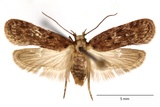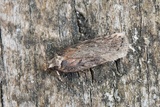Depressaria pulcherrimella Stainton, 1849 Species
Last modified: Nov. 29, 2024, 1:49 p.m.
A very rare species in Belgium.
Details
- Classification
- Family: Depressariidae > Subfamily: Depressariinae > Genus: Depressaria > Species: Depressaria pulcherrimella
- Vernacular names
- Klein platlijfje (NL), Pignut Flat-body (EN)
- First mention in Belgium
- De Crombrugghe G. 1912. Observations entomologiques faites au cours de l’année 1912. — Revue mensuelle de la Société entomologique namuroise 12: 110–111. On page 111 (as Depressaria pulcherrimella Stt.). view page
- Status
-
Native
Distribution
Caterpillar
Green with dark green dorsal line; head capsule yellowish; prothoracic plate green with black dots; last abdominal segment green.
Cocoon/pupa
A very loose spinning.
Bionomics
The exact oviposition site is unknown but it must happen in late summer or early autumn.
First instars are unknown, later instars feed on the flowers and the seeds of Conopodium majus where they construct a silken spinning that contorts the umbel. There is always only one caterpillar per umbel but caterpillars can use more than one umbel. On the other foodplants, the caterpillar makes a similar silk tube but it feeds on the leaves only. Caterpillars can be found in May–June.
The last instars construct a loose cocoon among leaf litter on the ground or in the upper layer of the soil.
Adults are active at night, they come to light and sugar.
Flight periods
One generation a year in August–September.
Observed on
- Host plant (species):
- Conopodium majus, Daucus carota, Pimpinella saxifraga and Meum athamanticum
The caterpillar prefers the flowers and seeds of Conopodium majus; it has also been observed feeding on the leaves of Daucus carota, Pimpinella saxifraga and very rarely on Meum athamanticum.



